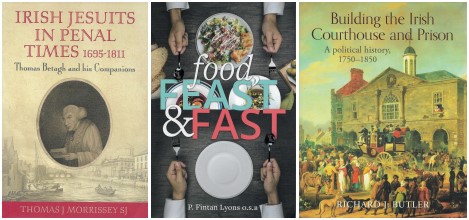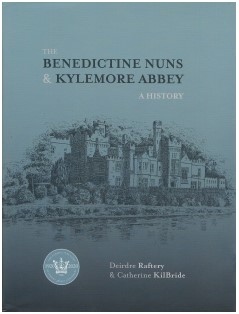BOOKWORM
Published in Book Reviews, Book Reviews, Issue 5 (September/October 2020), Reviews, Volume 28By Joe Culley
@TheRealCulls
In the last few years, in his 80s, Jesuit historian Todd Morrissey has produced more work than many scholars can claim for their entire career. Among his publications is a study of the archbishop of Dublin Daniel Murray (see Bookworm, HI 26.6, Nov./Dec. 2018), and another of the Trappist monk Dom Eugene Boylan. In his latest work, Irish Jesuits in penal times, 1695–1811: Thomas Betagh and his companions, Fr Morrissey examines the life and times of one of Archbishop Murray’s teachers, Thomas Betagh.
In order to place Betagh in context, however, Morrissey uses the first half of the book as a sort of primer on the penal laws and the political machinations of eighteenth-century Europe—including various wars of succession and the Seven Years’ War—which I have to confess I found quite useful. He also slips back into the seventeenth century for a quick review of the origins of Jansenism, the Jesuits’ support of the pope (ultramontanism) and the ultimate suppression of the order by Pope Clement in 1773. There is much talk of ‘Jesuit casuistry’, which, as a Jesuit old boy myself, is a stereotype in which I have always taken a perverse pleasure.
Not surprisingly, given that he served as headmaster of Crescent College, Limerick, Fr Morrissey’s focus is regularly on education. That was Murray’s legacy, and so, too, that of Meath native Betagh. He had attended a school founded by Jesuit John Austin at Saul’s Court in Dublin’s Temple Bar. He was sent to a seminary in Lorraine, France, and ordained there in 1766, two years after Louis XV suppressed the Society. Betagh returned to Ireland the following year and began educating the poor of the city. He died in 1811, and some 20,000 were reported to have turned out to pay their respects. Fr Morrissey tells the tale in a clear and easy prose, and you might even be encouraged to visit the grave of Fr Austin in St Kevin’s churchyard off Camden Street.
Fintan Lyons is a monk at Glenstal Abbey, so it is little surprise that his Food, feast and fast: the Christian era from ancient world to environmental crisis is imbued with a deep sense of contemplation. As the blurb has it, ‘Lyons weaves together an impressive body of historical and theological literature to argue that “the role of food, feast and fast in the Christian life” must now speak to what he calls “the looming environmental crisis”, with answers that are both spiritual and political’.
The book is meant to be dipped into as one investigates a ‘history of feasting and fasting, from Cain and Abel to the ascetic monks on Skellig Michael off the coast of Kerry, from the long-term consequences of the Black Death to the challenge of Calvin, and from De Tocqueville’s comments on the American diet. We learn of changes in the design of kitchens and dining rooms, the introduction of forks, and the histories of animal welfare and vegetarianism.’ It is always informative and regularly entertaining, but I wouldn’t call it an easy read. You have to pay attention.
Earlier this year (HI 28.1, Jan./Feb. 2020) we mentioned the gorgeous Ireland’s court houses, from the Irish Architectural Archive. Hot on its heels comes something of a companion piece, Building the Irish courthouse and prison: a political history, 1750–1850, by Richard J. Butler. As the title suggests, Butler’s focus is not simply on the architecture of the buildings but more—and extensively—on the social history behind their construction: who built them, who paid for them, why they were built and what they were used for. The answers are complex.

As Butler writes, ‘Throughout the period between 1750 and 1850, Irish local government—the grand-jury system—had a surprising degree of financial and political independence and this was reflected in the new courthouses and prisons that these elites built in provincial cities and towns. This book attempts to combine politics and architecture to better understand these networks of large, costly, and impressive new buildings.’
There is much to be learned from the prisons as well. Their condition ‘tended to reflect either positively or negatively on the grand jurors of a particular county, and when government officials and assize judges attempted to convince local elites to improve or rebuild their prisons, the strategy was often simply to shame or embarrass jurors by highlighting their supposed public respectability, civic responsibility, or humanitarianism’.
Though a most handsome (and heavy) production from Cork University Press, beautifully illustrated, it would nevertheless be a crime to describe this as a ‘coffee-table book’, though it would certainly sit well there. It is instead an impressive work of scholarship and seems likely to be the standard for some time.

The current Journal of the Kerry Archaeological and Historical Society contains plenty to savour. Bryan MacMahon has a look at the foundation and early years of the Tralee workhouse; Martin Moore tells the tale of the escape from Limerick Jail of IRA prisoners during the Civil War; and Brian Ó Conchubhair uses census records as the basis of an intriguing look at the county’s Jewish population, particularly in the early 1900s. Some interesting characters come into faint view, and who knows what a novelist could make of it all? (If only Kerry could produce a few writers …)
In her most recent publication, Irish servicewomen in the Great War: from Western Front to Roaring Twenties, Barbara Walsh aims to fill some large gaps ‘in the broader historiography of women’s lives during the close of the First World War and the early 1920s by focusing on the story of the Irish girls, drawn from every class, creed and ability, who volunteered with the Women’s Auxiliary Army Corps’. After examining the varied roles the women played during the conflict, Walsh looks at the roles they went on to play in a rapidly changing society.
Not surprisingly, on their return home the women received the same sort of mixed, and occasionally hostile, reception as the men who had joined the British Army, but they also had to adjust to a rapidly changing civil society. An interesting comparison is made between the fortunes of four of the women who married ex-servicemen: two couples stayed in Ireland while the other pair went to Australia.
 Martin O’Donoghue’s The legacy of the Irish Parliamentary Party in independent Ireland, 1922–1949 is ‘the first detailed analysis of the influence of former Irish Parliamentary Party members and methods in independent Ireland and the place of the party’s leaders in public memory … This study [uses] biographical data to provide the first statistical analysis of the Irish Party heritage within each political party in the independent Irish state established in 1922. Utilising a wealth of archival material, as well as contemporary and critical writings, it explores how former Irish Party followers reacted to the changed circumstances of independent Ireland. One chapter undertakes a case study of the Irish National League, arguing that this organisation, founded and led by former MPs, effectively constituted a “legacy party”.’
Martin O’Donoghue’s The legacy of the Irish Parliamentary Party in independent Ireland, 1922–1949 is ‘the first detailed analysis of the influence of former Irish Parliamentary Party members and methods in independent Ireland and the place of the party’s leaders in public memory … This study [uses] biographical data to provide the first statistical analysis of the Irish Party heritage within each political party in the independent Irish state established in 1922. Utilising a wealth of archival material, as well as contemporary and critical writings, it explores how former Irish Party followers reacted to the changed circumstances of independent Ireland. One chapter undertakes a case study of the Irish National League, arguing that this organisation, founded and led by former MPs, effectively constituted a “legacy party”.’
The Benedictine nuns and Kylemore Abbey: a history by Deirdre Raftery and Catherine KilBride is an attractive, heavily illustrated, centenary publication recalling the history of the order, of the nuns’ work at the school and monastery, and of the castle itself.
Thomas J. Morrissey SJ, Irish Jesuits in penal times, 1695–1811: Thomas Betagh and his companions (Messenger Publications, €19.95 pb, 160pp, ISBN 9781788121156).
P. Fintan Lyons OSB, Food, feast and fast: the Christian era from ancient world to environmental crisis (Columba Books, €19.99 hb, 408pp, ISBN 9781782183716).
Richard J. Butler, Building the Irish courthouse and prison: a political history, 1750–1850 (Cork University Press, €39 hb, 652pp, ISBN 9781782053699).
Tony Bergin (Hon. Ed.), Journal of the Kerry Archaeological and Historical Society, Series 2, Vol. 19 (free to members, 120pp, ISBN 9780993428982).
Barbara Walsh, Irish servicewomen in the Great War: from Western Front to Roaring Twenties (Pen & Sword, £19.99 hb, 190pp, ISBN 9781526767943).
Martin O’Donoghue, The legacy of the Irish Parliamentary Party in independent Ireland, 1922–1949 (Liverpool University Press, £80 hb, 300pp, ISBN 9781789620306).
Deirdre Raftery and Catherine KilBride, The Benedictine nuns and Kylemore Abbey: a history (Irish Academic Press, $19.95 hb, 210pp, ISBN 9781785373220).
















